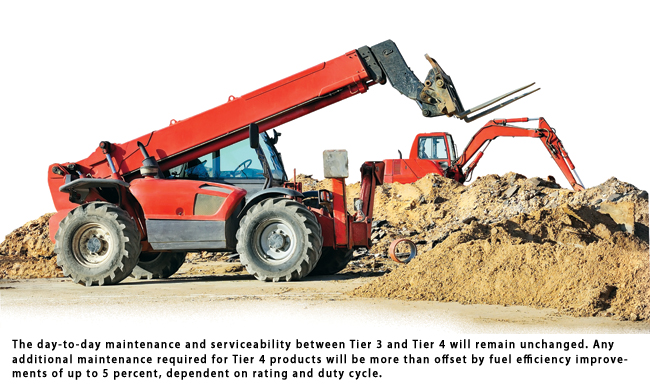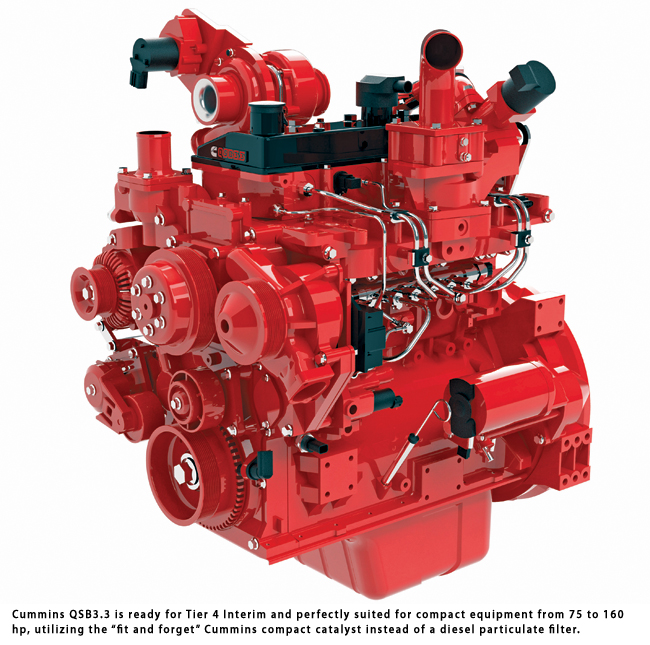Cummins Q&A
The next stage of emissions legislation is looming and its imminent arrival is driving considerable change in the diesel engine industry. The challenge of successfully meeting the new regulations is much greater than just the simple addition of new technology to the engine. It is a demanding investment in new manufacturing processes and techniques. The new, more complex technology demands a solid approach to product support with, for instance, service technicians needing new skills to diagnose, repair and maintain equipment. Other things won’t change at all.
We discussed some of these ideas with Clint Schroer, Cummins off-highway communications manager. Cummins is meeting the new Tier 4 Interim emissions standards for engines from 75 to 173 hp in a revolutionary way. The company has taken advantage of all its in-house expertise and its integrated technologies to custom-design the Cummins compact catalyst — a lighter, smaller solution that simplifies everything for compact equipment — says the company. Cummins has produced on-highway diesel oxidation catalysts since 1994. Leveraging this experience, Cummins Emission Solutions developed the compact catalyst, which is specifically designed and optimized for off-highway equipment.
CE: Talk about this new unique technology — the compact catalyst for Cummins. How is unique? What exactly does it do?
Schroer: For Tier 4 Interim 75 to 173 hp starting in Jan. 1, 2012, Cummins QSB6.7, QSB4.5 and QSB3.3 engines will meet the 2012 low emissions standards with an integrated Cummins compact catalyst exhaust after-treatment and a cooled exhaust gas recirculation [EGR] system incorporated on the engine. The cooled EGR system enables clean combustion with oxides of nitrogen [NOx] reduced by over 30 percent compared to Tier 3, while the clean engine combustion and Cummins compact catalyst exhaust after-treatment system reduces particulate matter [PM] by over 90 percent from engine exhaust.
The Cummins compact catalyst for Tier 4 Interim 75 to 173 hp is unique in that it is a compact size with minimal impact on equipment design and installation. It is maintenance free — no ash collection or removal. It has no operator interaction — a totally passive system — no lamps, no regeneration, no burner and no diesel particulate filter. And it is designed to last the entire life of the engine.
CE: What other technologies are you choosing for Tier 4 Interim, which begins in 2011?
Schroer: For Tier 4 Interim 174 to 751 hp starting in 2011, Cummins QSB6.7, QSL9, QSX11.9 and QSX15 engines will meet the 2011 low emissions standards with an integrated Cummins particulate filter exhaust after-treatment and a cooled exhaust gas recirculation system incorporated on the engine. The cooled EGR system enables clean combustion with NOx reduced by 45 percent compared to Tier 3, while the Cummins particulate filter exhaust after-treatment system reduces [PM] by over 90 percent.
CE: What do you think are the advantages of choosing an EGR system as opposed to selective catalytic reduction (SCR)?
Schroer: EGR technology recirculates exhaust gas to lower the combustion temperature and reduce NOx. SCR is an exhaust after-treatment system that functions by injecting an additional fluid, known as diesel exhaust fluid [DEF], ahead of the catalyst, with the resulting chemical reaction removing NOx. The debate between EGR and SCR has focused on how best to achieve fuel efficiency while minimizing the impact of Tier 4 on the operator. SCR is often less popular at Tier 4 Interim, due to the need for regular refilling of the additional fluid tank.
Cummins cleaner combustion with EGR enables up to 5 percent fuel economy gain without the use of any new fluids. SCR technology has a fuel economy improvement but requires the use of DEF also called urea, which typically has a usage up to 5 percent of the amount of diesel fuel. Both technologies require the use of ultra-low sulfur diesel fuel [ULSD] per the EPA regulation. Cummins has the most experience with all of these after-treatment and diesel engine technologies and selects the right technology for each market we serve. Using EGR technology for Tier 4 Interim provides the lowest cost of ownership and the easiest transition to Tier 4 Final.
CE: What lines of Cummins engines are focused on compact equipment — machines like skid steers, mini excavators, tractors, wheel loaders and telehandlers?
Schroer: Cummins QSB3.3 and QSB4.5 products are ready for Tier 4 Interim and perfectly suited for compact equipment from 75 to 160 hp, utilizing the “fit and forget” Cummins compact catalyst instead of a diesel particulate filter. Cummins also has a mechanical B3.3 product, with ratings from 60 to 85 hp. The B3.3 uses a Cummins in-cylinder solution to meet Tier 3 or Tier 4 Interim emissions below 75 hp [56 kW] with both naturally aspirated and turbocharged versions that deliver strong performance. It should be noted the EPA has different emissions regulations for engines below 75 hp, which allow manufacturers to meet Tier 4 Interim requirements without the need for after-treatment. Tier 4 Final begins in 2013 for this product range and will require after-treatment.
CE: This new technology must add up. How much more will these new engines cost for the end-user?
Schroer: Tier 4 equipment pricing will be determined by each OEM. In broad comparison terms to Tier 3, clearly, the introduction of Tier 4 will bring unavoidable cost increases with the addition of exhaust aftertreatment and enhanced engine technology. However, with up to 5 percent fuel-efficiency savings from Cummins Tier 4 engines, we will reduce the cost of operation to help offset equipment cost increases for Tier 4.
CE: Why do you think SCR is more popular for on-highway engine manufacturers, and why do you think EGR is more popular for off-highway engine OEMs?
Schroer: We need to be careful on this question to prevent confusion. The regulations are not the same for off-highway and on-highway. On the on-highway side EPA 2010 added SCR to an engine that already had a DPF and EGR. All the manufactures are implementing this EGR, DPF and SCR strategy except for Navistar, which is increasing its use of EGR rates and continuing the use of a DPF — both from EPA 2007.
In January 2014, EPA Tier 4 Final reduces NOx emissions by an additional 45 percent for engines above 173 hp and similar NOx reductions will also be required for engines above 74 hp in January 2015. While the gap between on- and off-highway emissions levels are closing, the effect dates for equivalent off-highway emissions levels generally lag on-highway by a few years. The Tier 4 Interim emissions regulations required in 2011 are broadly similar to those introduced in January 2007 for on-highway diesel trucks and buses. Tier 4 Final emissions regulations in 2014 will closely match those introduced Jan. 1, 2010, for on-highway applications, which utilize SCR today.
With only a three-year gap between the introduction of Tier 4 Interim and Tier 4 Final, Cummins will apply an approach to meet Tier 4 Final in the most effective way. At this point, both NOx and PM emissions will be at near-zero levels, comparable with the most stringent on-highway applications.
CE: What will change for contractors who buy these next-generation Tier 4 technology engines? Price, maintenance, fuel efficiency? How will these engines need to be used and treated differently than other diesel power plants?
Schroer: The day-to-day maintenance and serviceability between Tier 3 and Tier 4 will remain unchanged. Our base engine and added components will have the same robust design and durability as our current Tier 3 compliant products, which are achieving outstanding levels of reliability. Cummins understands that its customers value total cost of ownership and a transparent solution that is easy to maintain, and our customers will benefit from improved working environments with cleaner exhaust emissions [no smoke].
Cummins Tier 4 products will have the same fluid maintenance intervals. Also, to be complaint with Tier 4 legislation, Cummins incorporated a crankcase filter and an aftertreatment system. These required components have maintenance intervals aligned with other major maintenance intervals on the current product. The crankcase filter has a maintenance replacement interval every 2,000 hours. The EPA has set minimum intervals for Cummins particulate filter cleaning of 4,500 hours for above 173 hp [129 kW] and 3,000 hours for below 174 hp [130 kW]. For most applications this will be a very infrequent service event. All other technology changes will not pose any additional challenges.
Any additional maintenance required for Tier 4 products will be more than offset by fuel efficiency improvements of up to 5 percent, dependent on rating and duty cycle. This efficiency improvement without the use of any added fluids is a major benefit to the customer and one of the main reasons Cummins chose this technology for Tier 4 Interim.
Keith Gribbins is managing editor of Compact Equipment, based in Peninsula, Ohio.




Comments are closed here.